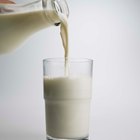
Milk is one of those food staples that are as nutritious as they are refreshing. Packed with vitamin D and other vitamins and minerals attractive to the human body, it’s no wonder the gallon of milk makes its way out of the refrigerator off and on throughout the day. Sometimes it ends up on the counter, sitting out for hours waiting for someone to notice. Just how long it can remain unrefrigerated is important when it comes to your health.
Refrigerator Storage
The U.S. Food and Drug Administration offers strict guidelines in regard to milk storage. According to these guidelines, milk requires refrigeration at or below 40 degrees Fahrenheit. If your refrigerator does not come with a thermometer that you can view, the FDA recommends placing a freestanding appliance thermometer inside the refrigerator to help you keep track of the temperature. Do not put milk back in the fridge after it's been left out above 40 degrees for two hours or more. Throw it away.
High Temperatures
FDA guidelines are even stricter when it comes to milk left unrefrigerated and exposed to high temperatures. If milk remains in temperatures of 90 degrees Fahrenheit or higher, the FDA says, it will only remain consumable for an hour before growth of dangerous bacteria associated with food borne illness becomes a health risk. After an hour, do not return the milk to the refrigerator -- throw it away.
Why Refrigerate?
Pathogenic organisms responsible for food borne illness are common in milk and other dairy products. Keep milk cold by storing it in the preferred temperatures to slow the growth of these pathogens. The FDA warns that outside of the refrigerator, pathogenic organisms double in number every 20 minutes. While healthy adults often recover from exposure to food borne illness, the elderly, pregnant women, young children and people who have weak immune systems may become seriously ill; in some cases, exposure can be life threatening.
Unpasteurized Milk
The milk you purchase in the supermarket undergoes pasteurization -- the process of heating milk to temperatures high enough to kill pathogens that cause typhoid, tuberculosis and other serious illnesses. It is a misconception by some that in exchange for the removal of harmful pathogens, consumers forsake nutrition. According to the FDA, this is not true. Some consumers opt for unpasteurized milk, which undergoes no treatment to kill pathogens, especially listeria monocytogenes. L. monocytogenes is capable of growing in the refrigerator, exposing the consumer to listeriosis -- a serious illness that can be fatal. While pasteurized milk is the healthier choice, it cannot remain outside the refrigerator longer than FDA guidelines suggest.
Related Articles

FDA Food Storage Temperature Guidelines

Why Does Milk Freeze in the ...

Does Cooking Raw Milk Pasteurize It?

Difference Between Fermented Milk & ...

Dangers of Goat Milk

How to Freeze Goat's Milk

How to Purchase Milk Crates

How Long Can a Bagel With Cream Cheese ...

Can You Drink Milk That Expires the ...

Whole Milk Vs. Lactaid Milk

How to Use Powdered Milk for Baking

Skim Milk Vs. Raw Milk

Benefits of Raw Milk

Soaking Dry & Chapped Hands in Milk

Does Soaking Elk Roast in Milk Do ...

What Is the Nutritional Value of Milk?

How to Mix Yogurt With Unflavored ...

Why Is Milk a Good Medium for Bacterial ...

How Long Can Cooked Chicken Be ...

What Happens if You Whip Condensed Milk?
References
- U.S. Food and Drug Administration: Food Safety for Moms-To-Be: While You're Pregnant -- Listeria
- U.S. Food and Drug Administration: Refrigerator Thermometers: Cold Facts about Food Safety
- Food Safety.gov: Refrigerated Food and Power Outages: When to Save and When to Throw Out
- U.S. Food and Drug Administration: The Dangers of Raw Milk: Unpasteurized Milk Can Pose a Serious Health Risk
Writer Bio
Jonae Fredericks started writing in 2007. She also has a background as a licensed cosmetologist and certified skin-care specialist. Jonae Fredericks is a certified paraeducator, presently working in the public education system.
Photo Credits
Goodshoot/Goodshoot/Getty Images